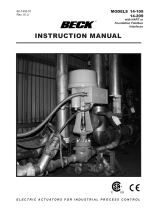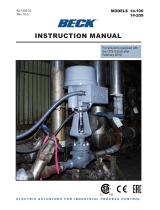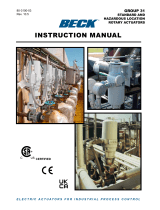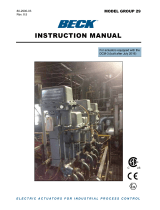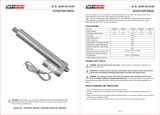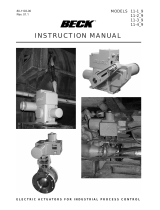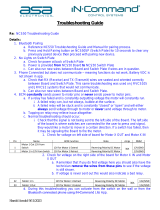Page is loading ...

ELECTRIC ACTUATORS FOR INDUSTRIAL PROCESS CONTROL
80-1403-01
Rev. 5.8
INSTRUCTION MANUAL
14-109
14-209
MODELS
with HART or
Foundation Fieldbus
Interfaces
For actuators equipped with the
DCM-3 (built after July 2016)
R

2
80-1403-01, Rev. 5.8
This manual contains the information needed to
install, operate and maintain Beck Model Group 14
electric actuators equipped with the Digital Control
Module (DCM-3), manufactured by Harold Beck &
Sons, Inc. of Newtown, Pennsylvania.
NOTICE: This manual contains information
that will make installation simple, ecient and
trouble-free. Please read and understand the
appropriate sections in this manual before
attempting to install or operate your actuator.
Group 22 digital actuators ... are
designed for accurate, reliable,
digital control in high torque
applications. The actuator is ideal
for use in large boiler applications,
such as ID/FD fan dampers.
Group 11 rotary actuators ...
provide precise position control of dampers,
quarter-turn valves, fluid couplings, and
other devices requiring up to 1,800 lb-ft
(2 440 N•m) actuator torque.
The Group 14 linear actuator is a powerful
control package designed to provide precise
position control of globe valves and other devices
requiring up to 4,000 lbs (17 800 N) of thrust.
INTRODUCTION

3
80-1403-01, Rev. 5.8
Product Description ................................................................................................................................... 4
............................................................................................................................. 6
Outline Dimension Drawings .................................................................................................................... 8
Installation ................................................................................................................................................. 10
Electrical ................................................................................................................................................ 12
Startup/Operation ..................................................................................................................................... 16
Digital Control Module (DCM-3) .............................................................................................................. 18
Features .............................................................................................................................................. 18
...................................................................................................................................... 22
Control End ................................................................................................................................................ 34
DCM-3 HART® ............................................................................................................................................ 38
Menus ................................................................................................................................................. 38
Messages ........................................................................................................................................... 48
Foundation Fieldbus ................................................................................................................................. 52
Parameters ......................................................................................................................................... 52
Transducer Block ................................................................................................................................ 54
Troubleshooting ........................................................................................................................................ 62
Electronics w/ Foundation Fieldbus .................................................................................................... 64
Electronics w/ HART® ........................................................................................................................ 68
DCM-3 Serial Interface .............................................................................................................................. 70
Setup .................................................................................................................................................. 70
Commands ......................................................................................................................................... 71
Maintenance ............................................................................................................................................... 79
Routine ............................................................................................................................................... 79
Component Replacement ................................................................................................................... 79
Appendix .................................................................................................................................................... 83
Spare Parts ......................................................................................................................................... 83
Components ....................................................................................................................................... 84
Index ........................................................................................................................................................... 88
Services ...................................................................................................................................................... 89
HART® is a registered trademark of the Hart Communication Foundation.
TABLE OF CONTENTS

4
80-1403-01, Rev. 5.8
Contactless
Posion
Sensor
(CPS‑5)
Switches
Digital Control
Module
(DCM‑3)
and Wiring
Terminal Board
Compartment
Tight‑Seater™
Coupling
Motor
The Group 14 product line is a family of linear
electric actuators designed for precise, reliable
operation of globe valves requiring up to 4,000
lbs (17 800 N) of thrust. Group 14 actuators
consist of a motor actuatorn gear box with self-
contained, micro-processor-based electronics for
modulating control. This section describes the
main components and general functions.
HOUSING
Beck actuators have individual cast aluminum
compartments for the main components: The
control motor, wiring terminal board / Digital Control
Module (DCM-3), drive and control end. Gasketed
covers and sealed shafts achieve Type 4 enclosure
ratings ideally suited to outdoor and high humidity
environments.
Heavy cast internal mechanical stops for the
output shaft are designed to prevent accidental
over-travel damage during manual cycling.
ACTUATOR
The Group 14 actuator consists of a control
motor, SLM, Handwheel, reduction gears, main
gear, and power screw output shaft. The ductile
iron main gear and the bronze nut and stainless
steel power screw output shaft are common to units
of a particular range of thrust and timing. The steel
of output gear, housing assemblies, and actuator
motors determine the actuator’s output thrust,
timing and stroke adjustment.
The output shaft travel is limited by mechanical
stops. The mechanical stop for the fully extended
or lower limit of the output shaft travel is not
adjustable. The position of the retracted or upward
travel mechanical stop is determined by the
number of washers on the output shaft between the
Tight-Seater™ and the lower bearing plate. This
the time of the order and is generally not changed
CONTROL MOTOR
The Beck control motor is a synchronous
motor that operates at a constant speed of 72
RPM (60 Rpm at 50 Hz). Typically, motors reach
full speed within 25 milliseconds and stop within 20
milliseconds.
Beck motors have double grease-sealed
bearings and require no maintenance for the life of
the motor.
SELF-LOCKING MECHANISM
(SLM)
An integral part of every control motor is the
self-locking mechanism. This mechanical device
couples the motor to the gear train and transmits
full motor torque in either direction. When the motor
is de-energized, the SLM prevents backdriving of
the output shaft.
HANDSWITCH
All Group 14 actuators are equipped with a
Handswitch for local electrical control. Refer to
MODES OF OPERATION (page 17).
WIRING TERMINAL BLOCK
the terminal block compartment. Refer to
INSTALLATION—ELECTRICAL (page 12).
DIGITAL CONTROL MODULE
(DCM-3)
In Automatic mode, power to run the motor is
controlled by the DCM-3 circuit board assembly.
This circuit board receives signals from the
GENERAL SPECIFICATIONS

5
80-1403-01, Rev. 5.8
external control system, interprets the signal as
an intended output shaft position, then runs the
motor until the output shaft matches that position.
information, maintains statistics related to actuator
performance, and creates signals to send back to
the external control system.
A DCM-3 model is available that communicates
with Foundation Fieldbus (FF) networks, and a
model is available that communicates with HART
Communication Foundation (HART) networks. The
FF models communicate using digital signaling.
The HART models can receive and send analog
and/or digital signals. The HART models include
systems that do not use the HART protocol. All
models have a “DB9” serial interface that can be
Refer to DCM-3 OVERVIEW (page 18).
CONTROL END
The control end provides electronic and electro-
mechanical sensing of the output shaft position.
Electronic sensing is provided by the CPS-5
Contactless Position Sensor, which provides a
signal to the DCM-3. The DCM-3 uses this signal
to determine the actual position of the output shaft.
Electro-mechanical sensing is provided by sets of
cam-operated switches. Two of these switches
act as over-travel limit switches to ensure the
motor cannot drive the output shaft beyond the
desired range. Other switches are available to the
external control system for indication and interlock
functions. Refer to OUTPUT SHAFT POSITION
SENSING (page 36) for information related to the
DCM-3 interaction with the CPS-5 signal. Refer
to CONTROL END OVERVIEW (page 34) for
information on setting up the control end.
SERIAL NUMBER
The Beck serial number is important in several
respects. The serial number begins with Group
number, which is followed by the model number.
These numbers allow a person to determine the
is followed by the sales order number. Using the
sales order as an index, Beck maintains complete
build information for every actuator built.
The serial number is stamped into the
actuator housing.
The serial number is also useful to the DCM-3.
Using the serial number, the DCM-3 can determine
the Group and model numbers, and from these can
available.
The format of the serial number is:
GG MMM-SSSSSS-LL-XX
e.g., 14-109-113065-01-02
where GG is the Group number
MMM is the model number
SSSSSS is the sales order number
LL is the sales order line item number
XX is the sales order sequence number
When entering the serial number into the
DCM-3, use the dashes as shown. The Group and
model numbers are mandatory entries because
information is useful for documentation, but is not
needed by the DCM-3. For information on how the
DCM-3 uses the serial number information, refer to
OUTPUT SHAFT POSITION SENSING (page 28).
TIGHT-SEATER™
The Beck Tight-Seater™ assembly is a
pre-loaded coupling that is installed between
the actuator output shaft and the valve stem. It
produces a controlled positive pressure against
the valve seat, independent of actuator thrust.
The Tight-Seater™ consists of four parts: A
housing attached to the output shaft, linear thrust
attached to the valve stem, and a threaded ring to
allow adjustment of the pre-load on linear thrust
discs.
The factory pre-load, by a threaded ring,
ensures that no relative motion occurs between the
operation until the pre-load thrust is exceeded in
the seated plug position of the valve.
When the seated plug position of the valve is
is stationary, and the output shaft exceeds the
pre-load pressure of the Tight-Seater™. When
the pre-loaded pressure is exceeded, the housing
will compress the linear thrust discs, maintaining
a controlled pressure on the valve seat, with the
shaft stationary.
Tight-Seater™
Cross-Section
Tight-Seater™

6
80-1403-01, Rev. 5.8
Actuator
Power
120 V ac, single-phase, 60 Hz (Standard), 50 Hz (Optional)
48, 72 or 180 watts
240 V ac, 50 or 60 Hz (Optional)
Allowable Tolerance +10%
-15%
Model Maximum Current and Power
120 V ac 240 V ac
14-109 .56 A 72 W .33 A 80 W
14-209 1.5 A 180 W .86 A 210 W
Operating Conditions -40° to 185°F (-40° to 85°C)
0 to 100% relative humidity, non-condensing
Communication Interface HART protocol (Rev. 5 -- burst mode is not supported), local pushbutton/
LEDs and local DB9 serial commands
FOUNDATION FIELDBUS and local DB9 serial commands.
Demand (analog) Signal Options 4–20 mA (1–5 V dc input is possible with the removal of the "R11"
(not available w/ FF) resistor located on the DCM-3 board. For resistor location, refer to
DCM-3 Test Points and Resistor (page 82))
Adjustability for Split Range 0%: 0.1 V to 4 V dc
Operation 100%: 0% + 1 V min. to 5 V max.
Minimum Step Size 0.1% typical (page 22)
Linearity ±1% of span, max. independent error
Hysteresis 0.25% of span at any point
Demand Signal Characterization Linear: Actuator output shaft moves proportionally to the input signal
Square: Actuator output shaft moves proportionally to the square of the
input signal
Custom: Actuator output shaft moves according to the custom demand
response curve
Position Feedback Analog Signal 4–20 mA (digital representation only with Foundation Fieldbus).
for Remote Indication
Isolation Demand input and position Feedback signals are isolated from ground
between the Demand and Feedback signals.
Action on Loss of Power Stays in place
Signal (Power On)
Stall Protection If the motor tries to run in one direction for more than 300 seconds
to the motor (feature can be enabled/disabled).
page 23.
GENERAL SPECIFICATIONS

7
80-1403-01, Rev. 5.8
Temperature Indication Measures the internal temperature of the actuator and triggers an
alarm when the temperature exceeds the rating range. Refer to
page 22.
Over-travel Limit Switches Two SPDT (Retract and Extend) provide over-travel protection. Refer
to page 36.
Auxiliary Switches Up to four 6 A, 120 V ac switches available. Switches are labeled S1
Handswitch Permits local electrical operation, independent of controller signal.
Standard on all units. An optional auxiliary contact can provide remote
AUTO indication (rated 2.5 A at 120 V ac).
Handwheel Provides manual operation without electrical power. Refer to page 17.
Motor 120 V ac, single-phase, no-burnout, non-coasting motor has instant
magnetic braking. Requires no contacts or moving electrical parts.
Stroke Adjustment Calibar simultaneously adjusts the stroke length, position feedback
signal, over-travel limit switches and auxiliary switches. The new
stroke displacement is produced by the full input signal.
Mechanical Stops Prevent overtravel during automatic or manual operation. Refer to
page 34.
Enclosure Precision-machined, aluminum alloy castings painted with corrosion-
resistant polyurethane paint provide a rugged, dust-tight, weatherproof
enclosure. Type 4; IP66.
Mounting Orientation Any orientation—no limitations.
Standards* CSA Labeled (US & Canada); CE Compliant; UKCA Compliant
*NOTE: May not be available with all options and models. For more information, please call Beck at 215-968-4600.
Basic
Model
Thrust
(lbs. / N)
Timing -- sec./in. (sec./cm.) Dimensional
Data
@ 60 Hz @ 50 Hz
14-100
340 / 1 513 4 (1.6) 5 (2)
Pages 8 & 9
425 / 1 891 11 (4.3) 13 (5.1)
600 / 2 670 16 (6.3) 19 (7.5)
650 / 2 893 8 (3.1) 10 (3.9)
800 / 3 560 11 (4.3) 13 (5.1)
1,000 / 4 450 27 (10.6) 32 (12.6)
1,100 / 4 895 16 (6.3) 19 (7.5)
1,620 / 7 209 48 (18.9) 57 (22.4)
1,800 / 8 010 27 (10.6) 32 (12.6)
14-200 2,700 / 12 015 16 (6.3) 20 (7.9)
4,000 / 17 800 24 (9.4) 29 (11.4)

8
80-1403-01, Rev. 5.8
5/16 [8] to 2 1/8 [54] travel (Dimensions in inches & [mm] )
Beck Model 14-100 & -200
NOTE: Actuators may be mounted in any orientation.
MODEL 14-100MODEL 14-200
OUTLINE DIMENSION DRAWINGS
Beck
Model
No.
Actuator Shaft
Travel Range
(in) [mm]
"A"
Valve Boss
Dia. Range
(in) [mm]
"B"
Yoke
Height
(in) [mm]
"C"
Nominal Drive
Shaft Extension
(in) [mm]
Max. Valve Stem
Extension (Valve
Stem Retracted
(in) [mm]
Approx.
Weight
(lb) [kg]
14-100 5/16–1 3/4 [8–44] 1–2 5/8 [25–67] 8 [203] 4 3/16 [106] 5 1/2 [140] 80 [36]
3/4–2 1/8 [19–54] 1 3/8–3 3/4 [35–95] 13 1/2 [343] 6 [152] 9 1/4 [235] 92 [42]
14-200 5/16–1 3/4 [8–44] 1 3/8–3 3/4 [35–95] 13 1/2 [343] 6 11/16 [170] 9 [229] 105 [48]
3/4–2 1/8 [19–54] 1 3/8–3 3/4 [35–95] 13 1/2 [343] 6 11/16 [170] 9 [229] 105 [48]

9
80-1403-01, Rev. 5.8
3/4 [19] to 4 1/2 [114] travel (Dimensions in inches & [mm] )
Beck Model 14-100 & -200
MODEL 14-100MODEL 14-200
NOTE: Actuators may be mounted in any orientation.
Beck
Model
No.
Actuator Shaft
Travel Range
(in) [mm]
"A"
Valve Boss
Dia. Range
(in) [mm]
"B"
Yoke
Height
(in) [mm]
"C"
Nominal Drive
Shaft Extension
(in) [mm]
Max. Valve Stem
Extension (Valve
Stem Retracted
(in) [mm]
Approx.
Weight
(lb) [kg]
14-100 3/4–3 1/2 [19–89] 1 3/8–3 3/4 [35–95] 19 13/16 [503] 12 5/16 [313] 9 1/4 [235] 100 [45]
1 3/4–4 1/2 [44–114] 1 3/8–3 3/4 [35–95] 19 13/16 [503] 12 5/16 [313] 9 1/4 [235] 100 [45]
14-200 3/4–3 1/2 [19–89] 1 3/8–3 3/4 [35–95] 19 13/16 [503] 13 [330] 9 1/4 [235] 113 [51]
1 3/4–4 1/2 [44–114] 1 3/8–3 3/4 [35–95] 19 13/16 [503] 13 [330] 9 1/4 [235] 113 [51]

10
80-1403-01, Rev. 5.8
SAFETY PRECAUTIONS
WARNINGWARNING
Installation and service instructions
are for use by qualied personnel
only. To avoid injury and electric
shock, do not perform any servicing
other than that contained in this
manual. Please read and understand
the appropriate sections in this
manual before attempting to install
or operate your actuator.
STORAGE INFORMATION
The actuator should be stored in its shipping
carton in a clean, dry area.
If it is necessary to store the actuator outdoors
for a long period of time, it should be removed from
its shipping carton and stored above ground. A
waterproof cover should be securely fastened over
it. Do not stack actuators on top of one another.
Stored actuators should be periodically checked
to make sure no condensation has formed in the
control compartments. Damage due to moisture
while in storage is not covered by warranty.
UNPACKING
Group 14 actuators are packed in standardized
cardboard shipping containers. Actuators mounted
on valves may be packed in cardboard containers
or strapped to a skid and crated, depending on
size. After unpacking, the wooden platform may
be used to transport the actuator to the installation
site.
INSTALLATION—MECHANICAL
Beck actuators can be furnished with valves
mounted as unitized assemblies ready for pipeline
installation.
CAUTION
Whenever an actuator is being
mounted on a valve, it is good
practice to remove the valve from
service. Observe the following
precautions:
• Know what uid is in the line.
• Wear proper protective
equipment.
• Disconnect the electrical power.
• Depressurize the pipeline.
• Refer to the valve maintenance
manual for specic instructions.
Mounting The Actuator On A
Valve
Refer to the figure below to identify the
mounting parts and the steps to install the
actuator onto the valve.
1. Prepare the valve. It may be necessary to
remove parts that are no longer used or to
replace or adjust packing. Refer to the valve
sheet that was shipped with the actuator for
valve stem that may be necessary.
2. Push the valve stem into the valve body to
the fully seated or stem down position.
3. Move the G-14 output shaft up into the
actuator body until the upper mechanical stop
is tight against the lower bearing plate .
4. Remove the four lower bearing plate bolts
that hold the bottom plate to the actuator
body (1/2" bolt heads). Pressure from the
mechanical stop will hold the plate in place
when the bolts are removed. Bolt the yoke
to the lower bearing plate using the longer
bolts supplied with the yoke. Torque bolts to
10 Ib-ft (13.5 N•m).
4
0
1
2
3
1
2
3
5
7
8
10
4
6
9
INSTALLATION

11
80-1403-01, Rev. 5.8
5. Place the jam nuts and travel index over the
valve stem before mounting the actuator on the
valve.
6. Remove the boss nut from the valve and place
the actuator and yoke over the stem and onto
the boss . Secure the yoke with the boss nut,
hand-tight.
7. Using the actuator Handwheel, lower the
actuator output shaft to contact the valve stem.
Thread the valve stem into the end of the
actuator output shaft. HINT: Rotate the whole
yoke/actuator assembly to get the valve stem
started into the actuator output shaft. Continue
lowering the actuator output shaft and threading
the valve stem until the actuator output shaft is
fully down on the mechanical stop.
8. Tighten the boss nut to secure the yoke and
tighten the yoke set screw .
9. Follow the valve seating adjustment procedure
on page 16 to complete the mounting.
Removing the Actuator from a
Valve
1. Move the Group 14 output shaft up into the
actuator body until the mechanical stop is
tight against the lower bearing plate .
electrical wiring from the actuator.
3. Loosen the valve stem jam nuts . Loosen the
boss nut
Loosen the yoke set screw .
4. Unthread the valve stem from the actuator
output shaft by turning the whole yoke/ actuator
assembly.
Valve Installation
The Beck actuator can be mounted in any
convenient orientation. There is no preferred
operating position.
Inspect the valve body to be sure that it is clean.
Be certain that other pipelines in the area are free
from pipe scale or welding slag that could damage
the gasket surfaces.
bolts are evenly torqued. Refer to the gasket
NOTE: The valve may have undergone
temperature variations in shipment. This
could result in seepage past the stem seals.
Refer to the valve manufacturer’s maintenance
instructions for packing adjustments, if
required.

12
80-1403-01, Rev. 5.8
Typical Wiring Connections, Foundation Fieldbus
Electrical installation requires the connection
of AC line power and the connection of signal
wiring. Without line power, the motor cannot run
and digital communications will not be functional.
Never connect power lines to signal connections.
The AC power is typically 120 V ac or 240 V
ac. Check the actuator nameplate. The signal
type is determined by the DCM-3 circuit board,
and can be either Foundation Fieldbus (page 20)
or analog/HART (page 20). Check the purchasing
documents for DCM-3 signal compatibility.
NOTE: The technicians installing the
equipment are responsible to make certain
the equipment installation is compliant to
national and local electrical codes.
Two conduit connections are provided for
supplying power and signal wiring to the unit.
Temporary plugs are installed in the conduit
entrances at the factory for shipping only and are
not intended for permanent use.
Conduits should be routed from below
the actuator so that condensation and other
contaminants flow away from the conduit. Prior
to actuator operation, all conduit entrances must
be properly sealed in accordance with National
Standards or Regulatory Authorities.
To maintain signal integrity and meet most
electrical codes, power and signal wires must be
routed to the actuator separately. The signal wiring
should be either shielded cables or be installed in
conductive conduit and/or cable trays.
Beck motors have negligible inrush current,
so wiring overload protection can be set only
moderately above the actuator rated current.
Beck actuators must always be properly
grounded.
A large, clearly labeled terminal block on the
side of the actuator is enclosed in a gasketed metal
enclosure. Terminals will accommodate up to 12
AWG (3.31 mm2) wiring. For the location of the
terminal block compartment, refer to the actuator
outline drawings starting on page 4.
Beck actuators are shipped calibrated and
written into the equipment order. If your actuator
does not appear to match the system requirements,
changes, contact the Beck factory.
All Beck actuators are shipped with a wiring
diagram that shows the correct wiring for that
actuator. Always refer to that wiring diagram to be
certain the correct connections are being made. If
be certain the attached wiring diagram is updated.
Field Wiring
Terminals
INSTALLATION Electrical

13
80-1403-01, Rev. 5.8
FOUNDATION FIELDBUS
COMMUNICATION OVERVIEW
The Foundation Fieldbus communication
interface is a method of superimposing digital data
onto a DC voltage power supply bus. Details and
the Fieldbus Foundation.
of using these function blocks. The Beck DCM-3
Transducer Block and three function blocks.
1. Resource Block
is not directly used in controlling the Beck
actuator. This block is a standard block
resembles all other standard Resource Blocks.
For typical automatic operation, this block
must be in Auto mode.
2. Transducer Block
is generally not directly used in controlling the
Beck actuator. The Transducer Block is used
of the actuator. For example, the direction
of rotation for an increasing set point is
determined by a setting in this block.
When installing the actuator pay particular
attention to Actuator Dir (Actuator_INFO2.
direction of actuator movement in response to
an increasing actuator set point (page 30).
For typical automatic operation, this block
must be in Auto mode, and the Op Mode
parameter (Actuator_OPERATING_MODE)
set to Hold.
3. Analog Output (designated Channel 1)
This is a standard Analog Output function
is used to control the Beck actuator. Because it
is a standard Analog Output block, it resembles
all other standard Analog Output blocks.
Apply the actuator set point to CAS_IN. The
actuator set point is typically scaled in “percent.
”This set point is propagated to Transducer
Block variable “Demand” (DEMAND_VALUE).
For typical automatic operation, set
Channel to 1, set SHED_OPT to NormalShed_
NormalReturn, and set the mode to Cas|Auto.
For information on how the actuator utilizes
Demand, refer to DEMAND (page 25).
4. Analog Input (designated Channel 2)
This is a standard Analog Input function
is used to measure thrust load on the output
shaft. This function is not available with the
Group 14.
5. Analog Input (designated Channel 3)
This is a standard Analog Input function
is used to measure the internal temperature of
the actuator. Because it is a standard Analog
Input block, it resembles all other standard
Analog Input blocks.
Minimum and maximum recorded
temperatures can be viewed in the Transducer
Block. For typical operation, set Channel
to 3, and set L_TYPE to Indirect. For more
information on temperature sensing, refer to
TEMPERATURE SENSING (page 22).

14
80-1403-01, Rev. 5.8
ANALOG CONTROL OVERVIEW
Actuators equipped with a HART / Local style
DCM-3 (P/N 20-5014-59) use a standard 4–20 mA
analog input signal for positioning. This design is
capable of providing very accurate control. Access
requires a HART interface or a serial interface.
Simple Position and Demand setup, as well as
simple diagnostics can also be accessed using the
pushbutton / LED interface on the DCM-3 board.
For information on the Demand adjustment, refer
to page 33; for information on the output shaft
position, refer to page 31.
When installing the actuator, give attention to
the direction the output shaft moves in response
to an increasing Demand signal. For more
information on travel direction, refer to page 29.
HART COMMUNICATION
OVERVIEW
The HART communication interface is a
method of superimposing digital data onto what
appears to be a conventional 4 mA to 20 mA control
are maintained by the HART Communication
Foundation (HCF).
In a typical HART application, the HART
signals share the two wires typically used for
targets analog systems based on the 4 mA to
20 mA, 250 ohm signaling convention. If the
lower than 250 ohms, digital communication may
fail. HART communication frequencies are 1200
Hz and 2200 Hz. Instruments powered from the
mA signal may not have a measurable resistance
the resistance appears to be 250 ohm at the
communication frequencies. Resistance of 250
ohm must terminate the connection. Consistent
with the connection scheme for actuators, Beck
uses a passive 250 ohm resistor on the DCM-3.
The HART communication system is based on
cyclic device polling. The control system initiates
writing and reading data.
some of the data content, but most of the data
device manufacturer, such as Beck. The DCM-3
HART interface has access to a large set of
data. To access this data, the technician’s HART
communication device must be aware of what data
is available. This data awareness is controlled by
what is called a Device Description (DD). The
Beck DD for the DCM-3 is registered with HCF and
is available from HCF. The proper DD is described
by the manufacturer number (Beck is 0x68) and
the DD number (0xEF).
For compatibility with older DCM installations,
the DCM-3 is able to be set to communicate with
HART devices using an older DD. However, the
older DD does not give access to all the DCM-3
functionality, and this DD should only be used if
the newer DD is not available. This older DD is
denoted by the same Beck manufacturer number
INSTALLATION Electrical

15
80-1403-01, Rev. 5.8
device can identify only one compatible DD type.
Therefore, to have the DCM-3 identify an older DD
necessary. This is accomplished by using the BCP
command harttype (page 74). This command
tells the DCM-3 which DD number to send to the
host. There are presently three DD’s created
by Beck and registered with HCF. Depending
on the documentation system, the DD’s may be
represented by the decimal values 1, 2, 239, or
may be represented by hexadecimal values 0x01,
0x02, 0xEF, respectively.
HART PRESENTATION OF DATA
Data available over the HART network is
independent of the type of host used to read the
data. Presentation of the data on a computer
by the HART or Beck protocol.
The protocol does specify a menu system,
and the DD contains the information needed
by the host to construct the menu system. This
instruction manual describes the HART interface
based on the menu system as included in the Beck
DD (DD number 0xEF).
SERIES CONNECTED
OPERATION
In some applications, two or more Beck
actuators may have the Demand signals connected
in series to operate multiple actuators from the
same signal. In this situation, the loop resistance
increases by 250 ohms for each Beck actuator. If
the Demand signal from the control system is an
analog signal and can drive the resistance created
by placing the actuators in series connection,
the analog system will operate as intended.
communication.
HART is not intended to be used with series
connected devices. Therefore, the control system
will not be able to communicate with the series
connected actuators. However, each actuator
will be able to be accessed one at a time if a
local HART host is connected directly across the
Demand signal of that actuator.
PARALLEL CONNECTED
OPERATION
In some applications, two or more Beck
actuators may have the Demand signals
connected in parallel to operate multiple actuators
from the same signal. In this situation, the loop
resistance should be maintained at 250 ohms
for the entire parallel connection. This is usually
accomplished by removing the 250 ohm resistor
from all DCM-3’s, then adding a parallel 250 ohm
actuator. In this situation, the loop remains at
250 ohm, the voltage generated across the 250
ohm resistor is 1 V dc to 5 V dc, and each DCM-3
Demand sensing circuit is fed the same voltage.
If any DCM-3 is removed, the voltage across the
If the actuator with the resistor is disconnected, the
loop resistance becomes too high.
HART can communicate with parallel
connected actuators because the loop remains at
250 ohm and all DCM-3 have access to the same
loop wires. In this situation, the polling addresses
of each DCM-3 should be made unique.
of each DCM-3 is set to 0, the HART standard for
single devices. If multiple actuators are sharing
the Demand loop, the polling addresses should be
changed before adding the actuator to the loop.
If there are two polling addresses the same, the
HART host will not be able to communicate. The
address regardless of whether the actuators are
already installed in parallel.
To change the polling address:
HART Modify parameter Poll addr.
BCP polladdr
at polling address 0. Looking for devices at other
addresses is called polling the bus. Some hosts
may not automatically poll the bus.

16
80-1403-01, Rev. 5.8
START-UP INSTRUCTIONS
After the actuator is mounted and its wiring
connections are made, it is ready to be tested for
proper operation.
Turn on the power supply. Operate the
actuator with the Handswitch and run it through
its full stroke, both directions. Observe that
the actuatorn device travels through its desired
stroke. If satisfactory, set Handswitch at the
“AUTO” position.
Turn on the controller and operate the
actuator by varying the control signal. Check
that the valve strokes in the proper direction
for a change in control signal. An increasing
control signal retracts the shaft and opens the
valve. With a 100% signal, the actuator is fully
retracted. If the valve does not stroke in the
proper direction, first check for proper wiring
connections and verify the control signal at the
actuator. If the wiring is correct, then reverse the
direction of travel (see page 29).
Valve Seating Adjustment
The actuator has a Tight-Seater™ attached
to its output shaft. The Tight-Seater™ allows
tight seating of the valve plug. It is a pre-loaded
coupling that allows the valve plug to seat
before the actuator reaches its lower limit. The
additional amount of travel compresses the
thrust discs inside the Tight-Seater™, causing a
controlled amount of thrust to hold the valve plug
on its seat when the actuator stem reaches its
lower limit. The Tight-Seater™ is factory-set to
produce a thrust matched to the valve and should
never be disassembled. Control of the amount of
valve stem threaded into the Tight-Seater™ may
be used to adjust the valve seating.
If readjustment of valve seating is necessary,
proceed as follows:
1. With the Handswitch, run the actuator to a
position above the 0% or lower limit position.
2. Loosen the lock nut on the valve stem and
thread the valve stem into the Tight-Seater™.
3. Run the actuator to the 0% position, using a
Demand signal source.
4. Thread the valve stem out of the Tight-Seater™
until the plug seats in the valve.
5. Raise the actuator shaft using the Handswitch
until the plug is clear of the seat and there
adjustment.
6. Thread the valve stem out of the Tight-Seater™
a fraction of a turn according to the valve stem
thread as listed (1/32" travel):
Thread Turn
3/8-24 3/4
7/16-18 5/8
1/2-20 5/8
3/4-16 1/2
7. Tighten the lock nut and index disc on the valve
stem.
8. Run the actuator to its lower limit using the
Handswitch. The valve stem should stop
before the actuator shaft stops.
9. Reposition the travel index.
CAUTION
If the valve stem is threaded directly
into the actuator shaft without
a Tight-Seater™, the valve stem
should be at least 1/4 turn from
the seated plug position when the
actuator shaft reaches the lower
limit. This will prevent damage to the
valve stem or seat. Do not attempt
to obtain tight shut-off without a
Tight-Seater™ as serious valve
damage may result.
START-UP/OPERATION

17
80-1403-01, Rev. 5.8
MODES OF OPERATION
There are three basic modes of actuator
control:
1. Handwheel operation
2. Handswitch operation, which is local electrical
control
3. Automatic mode, which is remote electrical
operation
The maximum available actuator travel is
Actuator Shaft Travel Range (page 7).
HANDWHEEL
Every Beck actuator is furnished with a
Handwheel to permit manual operation of the
valve or damper without electrical power. Its
solid construction design includes no spokes or
projections, and turns at a safe, slow speed. The
Handwheel is located at the bottom of the control
motor housing. The Handwheel is coupled directly
to the motor shaft and travels when the motor runs.
Before using the Handwheel, place the Handswitch
in the “STOP” position. Manual operation of the
Handwheel (with electric Handswitch in “STOP”
position) turns the motor and the rest of the drive
without incorporating a clutch.
Handwheel operation can be used at any time,
but is particularly useful during initial installation or
when power is not available. The Handwheel can
also be used as an indication of motor movement.
HANDSWITCH
Handswitch operation allows manual electric
control at the valve. In the “STOP” position, the
motor is electrically blocked from running. As a
safety feature, the Handswitch is designed so that
the controller can operate the actuator only when
the Handswitch is in the “AUTO” position. In the
“RETRACT” or “EXTEND” positions, the motor
runs to move the output shaft in the corresponding
direction. Refer to DIRECTION OF OUTPUT
SHAFT TRAVEL (page 30) for information on
interpreting the output shaft movement direction.
When moving the output shaft using the
Handswitch, the motor will stop when the over-
travel limit switches are actuated.
To prevent the Handswitch “RETRACT” and
“EXTEND” positions from running the motor,
A and C (page 12).
WARNINGWARNING
AC power to the actuator must be
o before removing the jumper.
AUTOMATIC
The actuator is in Automatic mode when
the Handswitch is in “AUTO.” In this mode, the
motor runs to move the output shaft to a position
as determined by a control system. The control
system signal to the actuator is called the Demand
signal and it can take several forms:
1. 120 V ac pulsed control
2. Analog control signal such as 4 mA to 20 mA
3. Digital network control
This instruction manual describes actuators
that accept analog signals, combined analog/
digital signals, and purely digital signals.
Regardless of the signaling technology,
basic automatic operation of the actuator is the
same: The motor runs so the percent of output
shaft angle matches the percent indicated by
actuator assures the proper relationship between
the Demand signal percentage and the shaft angle
percentage. All Beck actuators are shipped from
order.
In Automatic mode, motor voltage is controlled
by a computerized circuit board called the DCM-3.
Refer to the image on page 4 for the typical location
of the DCM-3.
MODE INTERACTION WITH
SIGNALS
The mode of operation can interact with
various actuator signals and diagnostic functions.
As described in AUTOMATIC, the Demand
signal does not operate the actuator unless the
Handswitch is in ”AUTO.” With the Handswitch in
other modes, the actuator monitors the Demand,
but Demand does alter the output shaft position.
Beck actuators also provide a signal output
so the control system can monitor the output shaft
position. This output signal is called Feedback,
and is available in all operating modes.
The DCM-3 computerized circuit board in
the Beck actuator monitors and records many
conditions and events. Some of these conditions
Handwheel or Handswitch modes. For example,
the DCM-3 does not count the number of motor
starts in Handwheel or Handswitch modes.

18
80-1403-01, Rev. 5.8
DCM-3 OVERVIEW
This instruction manual describes two basic
types of DCM-3. One type is compatible with
Foundation Fieldbus networks, and one type
is compatible with HART networks and analog
signals.
The DCM-3 is a computerized circuit board
that receives the Demand signal from the control
system, monitors the position of the output shaft,
and runs the motor to move the output shaft to
match the Demand signal. The DCM-3 also
provides alarms and status information back to
the control system, contains indicating LED’s for
local indication, and records information related to
actuator performance.
Output shaft position sensing is performed by
a circuit board located in the Control End called
the CPS-5. The CPS-5 sends a signal directly to
the DCM-3. Refer to the image on page 4 for the
typical location of the CPS-5.
in the DCM-3, the Control End applies some
limitations on the DCM-3 functionality. For
example, the DCM cannot cause the output shaft
to travel beyond the settings of the over-travel limit
switches that are located in the Control End. The
Control End is shipped from the factory entirely
not require changes. For more information on the
Control End, refer to OUTPUT SHAFT POSITION
SENSING (page 30), and CONTROL END
OVERVIEW (page 34).
Except for the interface being either
Foundation Fieldbus or HART/analog, most
aspects of the DCM-3 models are the same
regardless of the network type. For example,
both models have adjustable step size, measure
the output shaft position by monitoring the signal
from the CPS-5, and have the ability to measure
ambient temperature. Both models store the same
DCM-3 PHYSICAL LAYOUT
control system interfaces, but all are physically
interchangeable and have common features. The
physical interchangeability allows for adapting to
control system updates. The common features
provide a universal foundation for operation.
DCM‑3
LAYOUT
Mounng Screws
(4 places)
Overview LEDs
Direcon LEDs
Serial Port
Fuse
(ensure cover is
in place before
energizing)
Test Point 4
(TP4)
Test Point 2
(TP2)
Test Point 3
(TP3)
Test Point 1
(TP1)
Status
Indicaon LEDs
Pushbuons
Torque
Sensing
Connector
DCM-3 Features

19
80-1403-01, Rev. 5.8
FUSE
A fuse is located in the top left corner of the
illustration shown on the opposite page. This fuse
protects the motor wiring, but is not necessary for
the low power sections of circuit board. Therefore,
if the fuse is cleared, the circuit board will appear
to function but the DCM-3 cannot run the motor.
Because of the very low inrush current of Beck
motors, the peak motor current is much lower than
the fuse rating. Fuse clearing is extremely rare, and
is almost always caused by erroneous customer
wiring during installation.
ALARM OUTPUT RELAY
A solid state relay is included to connect line
power to an external alarm circuit. Typically, any
condition that lights the STAT LED also issues an
external alarm through this relay. The choice can
be made if the relay indicates alarm by closing or
opening. Also, the exact status indications that can
signal an alarm can be set through a mask. Refer
to ALARM OUTPUT CONFIGURATION (page 23).
BECK CONFIGURATION PORT
(BCP)
Beck factory testing. The port uses traditional
“DB9” signaling, and can access all internal
DCM-3 parameters and information. This port
not related to Foundation Fieldbus or to HART
interfaces. Both Foundation Fieldbus and HART
communicate through the Demand signal wiring at
OVERVIEW LEDs
Located on the DCM-3 board (pictured at left),
these LEDs indicate the basic, real-time state of
the actuator. A description of each LED follows.
STAT
This red LED illuminates during a system alarm.
Explanation of the specific alarm is available
through the Fieldbus or Serial interface. See the
Troubleshooting section for additional information.
REV
This green LED illuminates when the actuator is
receiving a Demand signal less than its position.
FWD
This green LED illuminates when the actuator is
receiving a Demand signal greater than its position.
PWR
This green LED illuminates when power is applied
to the actuator. This LED pulses from bright to dim
indicating the DCM-3 is operational.
OVERVIEW LEDs
DIRECTION LEDs
These green LEDs indicate the direction of
travel resulting from an increasing Demand signal.
DIRECTION
LEDs
A = EXT B = RET

20
80-1403-01, Rev. 5.8
DCM-3 FOR FOUNDATION
FIELDBUS
The Foundation Fieldbus version of the
parameters.
DCM-3 FOR ANALOG OR HART
The HART version of the DCM-3 interfaces to
analog systems and HART systems. This model of
DCM-3 includes a pushbutton and LED interface to
changes resulting from the pushbuttons can be
read through the computer interface.
PUSHBUTTON CONTROLS
(not available with Foundation Fieldbus)
The pushbuttons provide a simple method of
ranges. These buttons overwrite internal DCM-3
signal ranging information. If using a HART
use the pushbuttons. Although the systems fully
cooperate inside the DCM-3, the values inserted
the values written by the HART communicator.
When using the pushbuttons, pressing a button
will cause the DCM-3 to stop trying to run the motor
until the button is released. When pressing any
panel that were illuminated will temporarily pause
from illuminating.
Pressing only one button will cause the DCM-3
and the appropriate range button must be pressed
both buttons until the DCM-3 acknowledges.
The DCM-3 acknowledges successful requests
by lighting ACKNOWLEDGE. If signal ranges are
inappropriate for the request, the DEMAND or
POSITION LED will light.
For instructions on using the pushbuttons,
refer to sections DEMAND (page 32) and OUTPUT
SHAFT POSITION SENSING (page 38).
PUSHBUTTON
CONTROLS
DCM-3 Features
/
